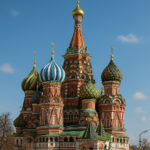
Nestled on the banks of the majestic Danube River in Budapest, Hungary, stands a timeless testament to the nation’s history, culture, and democracy—the Hungarian Parliament Building. With its awe-inspiring Neo-Gothic design, intricate details, and rich heritage, the Parliament Building has captured the imagination of visitors from around the world. From its imposing façade to its ornate interiors, each aspect of this iconic landmark tells a story of resilience, craftsmanship, and national pride. Join us as we embark on a journey to discover the beauty and significance of the Hungarian Parliament Building, a symbol of Hungary’s past, present, and future.
The Hungarian Parliament Building stands as an iconic symbol of Hungarian architecture and governance. Stretching an impressive 268 meters (879 ft) in length, it holds the distinction of being the longest building in Hungary. Its elongated structure dominates the landscape of Budapest, contributing to the city’s skyline with its magnificent Neo-Gothic design. The length of the building reflects the grandeur of its purpose, housing the country’s legislative body and serving as a beacon of democracy. Its sheer size commands attention and awe from visitors and locals alike, marking it as a focal point of Hungarian history and identity.
Rising proudly above the Hungarian Parliament Building is its majestic dome, reaching a towering height of 96 meters (315 ft). This dome, the second tallest in Budapest after the St. Stephen’s Basilica, serves as a prominent architectural feature of the structure. Its impressive stature symbolizes the strength and resilience of the Hungarian nation, while its intricate design adds to the building’s overall aesthetic appeal. Standing as a testament to the ingenuity of the architects who designed it, the dome is a defining characteristic of the Parliament Building’s skyline, drawing admiration from all who behold it.
Within the walls of the Hungarian Parliament Building lie 386 chambers, each serving a specific function in the legislative process. Among these chambers, 199 are dedicated offices, providing workspace for the parliamentarians who govern the nation. Additionally, the building boasts 123 committee rooms, facilitating the discussion and decision-making processes integral to Hungary’s governance. These chambers represent the heart of the country’s democracy, where laws are debated, policies formulated, and the voice of the people is represented.
Navigating the labyrinthine corridors of the Hungarian Parliament Building, one encounters a network of 29 staircases and 10 courtyards, each contributing to the building’s architectural complexity. These staircases serve as conduits for movement within the vast structure, allowing parliamentarians, staff, and visitors to traverse its many levels. The courtyards, nestled amidst the building’s wings, provide pockets of open space and natural light, enhancing the overall ambiance of the interior. Together, these staircases and courtyards form an integral part of the building’s design, facilitating both functionality and aesthetic appeal.
A remarkable feat of construction, the Hungarian Parliament Building rests upon a foundation of 40 million bricks. These bricks, meticulously laid by skilled craftsmen over the course of the building’s construction, form the bedrock upon which Hungary’s democracy stands. Each brick bears witness to the dedication and craftsmanship of those who contributed to the building’s creation, underscoring the monumental effort required to erect such a grand structure. As a testament to enduring strength and resilience, the millions of bricks that comprise the Parliament Building’s foundation serve as a tangible reminder of Hungary’s rich architectural heritage.
Illuminating the interior of the Hungarian Parliament Building are 18,000 square meters (193,750 sq ft) of stained glass windows, comprising the largest stained glass window collection in Europe. These intricate windows, crafted with precision and artistry, adorn the building’s interior with a kaleidoscope of colors and patterns. Each window tells a story, depicting scenes from Hungarian history, culture, and tradition. As sunlight filters through the stained glass, it casts vibrant hues across the chambers and corridors, creating a mesmerizing visual spectacle that captivates all who behold it.
Dominating the façade of the Hungarian Parliament Building is the Hungarian coat of arms, an imposing symbol of national identity and pride. Towering at 8 meters (26 ft) in height and 4 meters (13 ft) in width, this iconic emblem commands attention, serving as a visual representation of Hungary’s heritage and values. Crafted with meticulous attention to detail, the coat of arms stands as a testament to the craftsmanship of the artisans who sculpted it. Positioned above the main entrance, it welcomes all who enter the hallowed halls of the Parliament Building, symbolizing the unity and strength of the Hungarian nation.
Safeguarded within the Central Hall of the Hungarian Parliament Building is the Hungarian Holy Crown, a revered symbol of Hungarian statehood and sovereignty. Encased behind bulletproof glass, this ancient relic holds immense historical and cultural significance for the Hungarian people. Believed to date back to the 11th century, the Holy Crown has been passed down through generations of Hungarian monarchs, serving as a tangible link to the nation’s storied past. Its presence within the Parliament Building speaks to the continuity of Hungarian governance and the enduring legacy of its rulers.
The construction of the Hungarian Parliament Building spanned an impressive 19 years, commencing in 1885 and culminating in 1904. Designed by Hungarian architects Imre Steindl and Miklós Ybl, the building represents a masterpiece of Neo-Gothic and Renaissance architecture. The meticulous planning and execution required for such a monumental undertaking are evident in every detail of the structure, from its ornate façade to its intricate interior. The prolonged construction period reflects the dedication and perseverance of all those involved in bringing the Parliament Building to fruition, resulting in a timeless symbol of Hungarian identity and democracy.
Adorning the Hungarian Parliament Building, both inside and out, are over 100,000 sculptures, each contributing to the building’s ornate beauty and historical significance. These sculptures, crafted by skilled artisans, depict a myriad of subjects ranging from historical figures to mythical creatures. From the intricate carvings that adorn the façade to the statues that grace its halls, each sculpture tells a story, capturing moments of Hungarian history and culture. As integral components of the Parliament Building’s design, these sculptures serve as enduring symbols of artistic excellence and national pride.
The Hungarian Parliament Building boasts an extensive network of 40 kilometers (25 miles) of electrical wires, facilitating modern conveniences and infrastructure within its historic walls. These wires power the building’s lighting, heating, and technological systems, ensuring its functionality and comfort for occupants and visitors alike.
Standing sentinel at the entrances to the Hungarian Parliament Building are 2 Hussar statues, imposing figures of Hungarian cavalrymen mounted on horseback. These statues, towering at 15 meters (49 ft) in height, pay homage to Hungary’s rich military history and heritage. Their presence evokes a sense of strength and valor, guarding the Parliament Building with unwavering vigilance.
Positioned on the banks of the Danube River, the Hungarian Parliament Building commands a picturesque location, measuring 47 meters (154 ft) wide at this point. Its riverside setting provides a stunning backdrop, enhancing the building’s grandeur and visual appeal. The proximity to the Danube River also serves as a reminder of Hungary’s geographical significance and historical ties to the waterway.
As night falls, the Hungarian Parliament Building is bathed in light, illuminated by 365 lamps that adorn its façade. Each lamp represents a day of the year, casting a warm glow that accentuates the building’s architectural features and highlights its beauty. The nightly illumination transforms the Parliament Building into a mesmerizing spectacle, captivating onlookers and adding to its allure as a symbol of Hungarian identity.
A striking feature of the Hungarian Parliament Building is its collection of 109 ornate gargoyles, each meticulously crafted with unique designs and purposes. These grotesque yet captivating figures adorn the exterior of the building, serving both decorative and functional roles. With their intricate carvings and intricate details, the gargoyles add an element of whimsy and intrigue to the Parliament Building’s façade, inviting closer inspection and appreciation of their craftsmanship.
The construction of the Hungarian Parliament Building was a monumental endeavor, estimated to have cost 41 million forints during its completion in the early 20th century. Adjusted for inflation, this would equate to roughly 2 billion Hungarian forints today, equivalent to around $5.6 million USD. The substantial investment required for its construction underscores the importance and significance of the Parliament Building as a symbol of Hungarian democracy and national pride.
Between 2010 and 2014, the Hungarian Parliament Building underwent a major renovation project, demonstrating a commitment to preserving its historic legacy and architectural splendor. At a cost of 18.6 billion forints (approximately $70 million USD), the renovation addressed structural issues, restored decorative elements, and upgraded facilities to ensure the building’s continued prominence for generations to come.
With 690 windows and 41 doors, the Hungarian Parliament Building features a multitude of openings that contribute to its architectural grandeur and functionality. These windows and doors provide natural light, ventilation, and access throughout the building, enhancing both its aesthetic appeal and practical utility.
The Hungarian Parliament Building holds the prestigious honor of being featured on the 10,000 Hungarian forint banknote, further solidifying its status as a national symbol and cultural landmark. The depiction of the Parliament Building on the currency serves as a testament to its historical significance and enduring legacy in the hearts and minds of the Hungarian people.
Drawing visitors from around the world, the Hungarian Parliament Building welcomes more than 1 million tourists annually, eager to marvel at its architectural splendor and delve into its rich history. Guided tours offer insight into the building’s design, construction, and role in Hungarian governance, providing visitors with a deeper appreciation for this iconic landmark.
Beneath the Hungarian Parliament Building lies an underground car park capable of accommodating 170 cars, providing convenient parking for parliamentarians, staff, and visitors.
The Hungarian Parliament Building has left its mark on the silver screen, appearing in several films including “I Spy” (1967), “Munich” (2005), and “Hellboy” (2004), further cementing its status as an iconic cultural landmark.
Reflecting its significance and prominence, the Hungarian Parliament Building has been assigned its own unique zip code, 1055 Budapest, underscoring its status as a distinct and recognized entity within the city.
The Hungarian Parliament Building stands as a testament to the enduring legacy of Hungarian architecture, boasting a rich history and architectural significance that continues to captivate and inspire visitors from around the globe.
With its rich history, architectural splendor, and cultural significance, the Hungarian Parliament Building serves as a beacon of democracy, symbolizing the strength, resilience, and unity of the Hungarian nation.
Hungarian Parliament Building: FAQs for the Crown Jewel of Budapest
The Hungarian Parliament Building is a breathtaking landmark in Budapest, Hungary, and a UNESCO World Heritage Site. Here’s a comprehensive FAQ to quench your curiosity about this architectural marvel:
1. What is the architectural style of the Hungarian Parliament Building?
The Hungarian Parliament Building is a prime example of Gothic Revival architecture, with some elements of Renaissance Revival sprinkled in. The symmetrical facade boasts pointed arches, spires, and pinnacles, reminiscent of medieval European cathedrals. The central dome, however, draws inspiration from the Renaissance style with its grand size and cupola.
2. When was the Hungarian Parliament Building constructed?
Construction began in 1885 to commemorate the 1,000th anniversary of Hungary’s founding. The architect, Imre Steindl, aimed to showcase Hungary’s economic and political power at the time. The building was officially completed in 1896, but it wasn’t fully operational until 1904.
3. What is the size of the Hungarian Parliament Building?
The Hungarian Parliament Building is massive! It stretches 268 meters (879 feet) long and 123 meters (404 feet) wide. The dome reaches an impressive height of 96 meters (315 feet), making it one of the tallest buildings in Budapest, tied with St. Stephen’s Basilica.
4. Is the Hungarian Parliament Building still functioning as a Parliament House?
Yes, the Hungarian Parliament Building is the current seat of the Hungarian National Assembly. The building has two identical chambers on opposite sides. One chamber is used for the regular sessions of the National Assembly, while the other is used for ceremonies, conferences, and guided tours.
5. Can I visit the Hungarian Parliament Building?
Absolutely! The Hungarian Parliament Building offers guided tours in several languages. Tickets can be purchased online or at the Visitor Centre on the Kossuth Lajos Square side of the building. Keep in mind that tours may be cancelled due to parliamentary sessions or state events.
6. What are some interesting facts about the Hungarian Parliament Building?
- The building has a staggering 691 rooms, including over 200 offices!
- The facade is adorned with 242 sculptures depicting Hungarian kings, historical figures, and mythical creatures.
- The Hungarian Crown Jewels, including the Holy Crown of Hungary, are on display inside the building (although not always accessible to the public).
- The dome is covered in 40 kg (88 lbs) of 23-carat gold! This glints spectacularly in the sunlight.
- During the communist era (1949-1989), a red star was placed on the dome as a symbol of the socialist regime. This was removed after the fall of communism.
7. How can I get to the Hungarian Parliament Building?
The Hungarian Parliament Building is located on the banks of the Danube River in Budapest. It’s easily accessible by metro (Ⓜ️ lines M2 and M4), tram (tram lines 2 and 19), or bus (bus routes 15, 70, and 78). If you’re coming by car, there are limited parking options around the building.
Hopefully, this FAQ provides a comprehensive overview of the Hungarian Parliament Building. From its architectural grandeur to its historical significance, this iconic landmark is a must-see for any visitor to Budapest.









